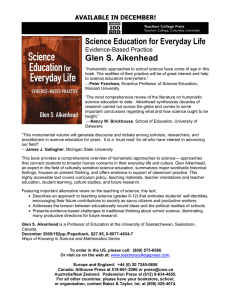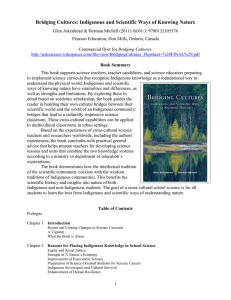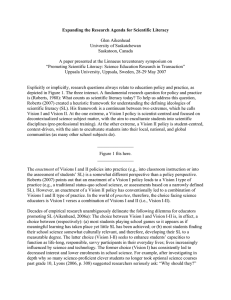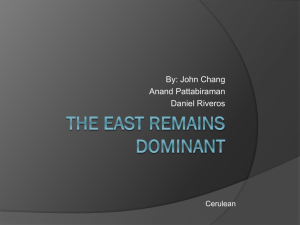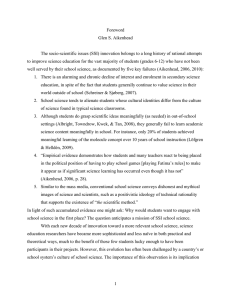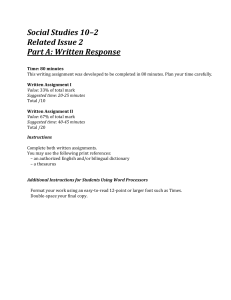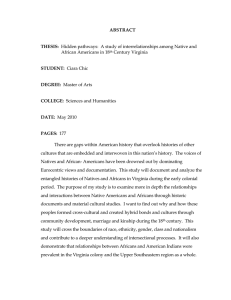Glen S. Aikenhead Importation of Science Programs from Euro-American Countries into
advertisement
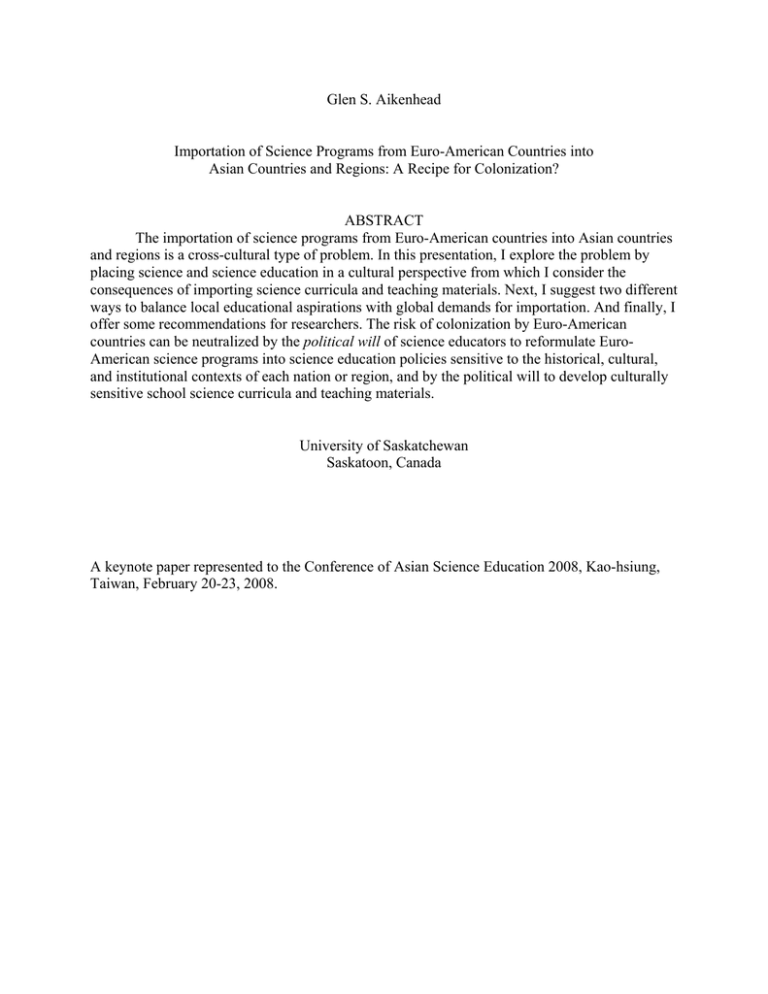
Glen S. Aikenhead Importation of Science Programs from Euro-American Countries into Asian Countries and Regions: A Recipe for Colonization? ABSTRACT The importation of science programs from Euro-American countries into Asian countries and regions is a cross-cultural type of problem. In this presentation, I explore the problem by placing science and science education in a cultural perspective from which I consider the consequences of importing science curricula and teaching materials. Next, I suggest two different ways to balance local educational aspirations with global demands for importation. And finally, I offer some recommendations for researchers. The risk of colonization by Euro-American countries can be neutralized by the political will of science educators to reformulate EuroAmerican science programs into science education policies sensitive to the historical, cultural, and institutional contexts of each nation or region, and by the political will to develop culturally sensitive school science curricula and teaching materials. University of Saskatchewan Saskatoon, Canada A keynote paper represented to the Conference of Asian Science Education 2008, Kao-hsiung, Taiwan, February 20-23, 2008. International Science Education We are fortunate to be able to draw upon a chapter in the Handbook of Research on Science Education written by Dr. Chorng-Jee Guo (2007), President of the National Taitung University, Taiwan. He reviewed science education research from an international perspective and pointed out a worldwide trend towards transforming globalization and a knowledge economy into pervasive goals for school science. But he quickly added that these goals are seriously flawed because they ignore two major problems that all countries face today: 1. How can we motivate, teach, and assess students’ learning in science so that “optimal results can be obtained for students’ individual development and for the benefit of society as a whole” (p. 249). 2. A mismatch exits between, on the one hand, the conventional goal of school science to select and train elite students for science and engineering careers, and on the other hand, the 21st century goal supported by a new worldwide consensus on school science being relevant to events and issues in students’ daily lives, now and in the future. Globalization and a knowledge economy offer no resolution to these two pressing problems. Therefore, globalized science education does not hold much promise for successful school science reform in most countries; yet many education jurisdictions in Asia are under political pressure to import Euro-American science programs into their schools to conform to a globalization movement. This is a troubling dilemma, which I explore in this presentation. Even worse than ignoring fundamental problems faced by all countries, globalization of science education in practice advances a narrow, Euro-American, positivist version of school science (Eisenhart et al., 1996); for example, programs such as America’s National Research Council’s Standards (NRC, 1996) and Project 2061 (AAAS, 1989). I have two points to make in my introduction to this presentation. First, decades of science education research indicate that such programs are not educationally successful in Euro-American countries themselves (Aikenhead, 2006, Ch. 3; Eisenhart et al., 1996). The type of school science advanced by Standards and Project 2061 has contributed significantly to: (1) reducing student enrolment in most science programs; (2) exacerbating social injustice that arises from the alienation of students who belong to certain cultures, subcultures, or socioeconomic groups, and who are consequently underrepresented in tertiary science and engineering programs and related careers; (3) conveying dishonest and mythical images about professional science and scientists, thereby discouraging capable students 2 who might otherwise persevere in science programs; and (4) inhibiting most students from learning science content meaningfully because the programs unintentionally encourage students to play school games (known as “playing Fatima’s rules;” Aikenhead, 2006) to obtain high school credentials with little or no understanding of the course content. If conventional school science programs are educational failures in Euro-American countries, why would Asian countries and regions want to import them? These programs, however, are certainly not political failures in Euro-American countries; a topic I return to at the conclusion of this presentation. Second, I concur with Guo (2007) and Gray (1999) when they conclude that over the years, science curricula and pedagogy that are developed within one cultural milieu do not import well into other cultural milieu. For example, the attempt at importing a 1970s American inquiry teaching method into Korea led to dysfunctional classrooms (Lee et al., 1988). The researchers attributed this failure to political realities such as: American foreign policy, intellectual ethnocentrism, cultural differences between nations, and the self-interests of a few Korean educators in positions of authority. A different type of example comes from Canada’s rejection of Standards and Project 2061 because these programs were developed by Americans for Americans. Although the nations of Canada and the United States are the closest of friends, they differ in their history, social institutions, and culture. Consequently, when a national science curriculum framework was developed in Canada in the 1990s, it focused on Canadian culture. For instance, rather than importing the American goal to assimilate all students into thinking like a scientist (an elitist theme; Jenkins, 2007), a foundational goal of the Canadian framework emphasized a science-technology-society-environment (STSE) approach concerned with school science being relevant to events and issues in students’ out-of-school lives (CMEC, 1997). If Canadian and American cultures differ sufficiently to negate the importation of American science reform programs into Canada, then why would Asian countries and regions want to import those programs? The importation of science programs into Asian countries and regions is a cross-cultural type of problem. In this presentation, I explore the problem by placing science and science education in a cultural perspective, from which I consider the consequences of importing science curricula and teaching materials. Next, I suggest two different strategies to balance local educational aspirations with global demands for importation. And finally, I offer some recommendations for researchers. 3 A Cultural Perspective on Science and Science Education I consider scientists to be people originally trained by university science departments worldwide and then employed, for instance, by the military, business, industry, government agencies, private foundations, and to a small extent, by universities. In short, these are people employed mostly in a social context of power and privilege associated with research and development (R&D), patents, economic progress, and globalization (Jenkins, 2007). These professionals are paid by their institutions to generate, transform, or use knowledge for the purpose of benefiting those institutions. Scientists collectively work within a subculture (or a paradigm) that frames their thinking and practice in the context of that work (Kuhn, 1970; Traweek, 1992). For most scientists, this subculture is Eurocentric in nature (Aikenhead & Ogawa, 2007). Therefore, I refer to their professional enterprise as Eurocentric science. The great amount of heterogeneity that exists within this enterprise is depicted by the plural term: Eurocentric sciences. Some scholars follow the convention of referring to this enterprise as Western science or Western Modern Science. The scientific enterprise is also known as “the culture of science” in cultural anthropology (e.g., Kawada, 2001; Pickering, 1992) to emphasize the group’s shared norms, values, beliefs, language, expectations, technologies, and conventional actions. Eurocentric sciences are first and foremost cultural in their nature. Foundational to any culture are the values that guide its members. In the culture of Eurocentric sciences, scientists invariably adhere to the anthropocentric value of gaining power and dominion over nature (Liu & Lederman, 2007; Mendelsohn & Elkana, 1981). Their knowledge is formally and “objectively” decontextualized to avoid making normative prescriptions for human action. Values within scientific knowledge systems are anchored in Cartesian dualism (in almost all cases), reductionism (in most cases), and quantification (in many cases). Some exceptions are described, for example, by Hazen (2005), Loo (2005), Turner, Ignace, and Ignace (2000), and Worster (1994). Kuhn (1970) asserted that values guide a scientific judgment concerning evidence and theories, and that values guide the scientific process of reaching a consensus on what is considered to be “true” (e.g., values such as predictable consistency, generalizability, success at initiating novel experimental research, and respect for colleagues’ expertise). Holton (1978) published several case studies to show how different values held by scientists can alter the development of Eurocentric sciences. 4 A cultural perspective on science education is also a reasonable one to assume (Aikenhead, 1996). However, the culture of Eurocentric sciences and the contexts of their R&D differ dramatically from the culture of schools and the contexts of science classrooms. Unlike scientists, science teachers respond to conflicting needs of diverse students, and at the same time, teachers need to get through the week burdened with increasing professional responsibilities. In this context, one can understand why many science teachers convey to their students cultural myths such as: the scientific method (i.e., the five-step method followed by scientists); realism (i.e., scientific logic applied to one’s senses results in a direct connection with nature and a true reflection of things as they really are, which implies that scientists describe reality independent of their act of perceiving); and positivism (i.e., inductive and deductive logic applied impartially to theory-neutral observations and to strict empirical and experimental methodologies, all of which yield objective, value-free, universal, secure knowledge of nature). The naïve bliss of realism and the false security of positivism give teachers an authoritative force that helps them deal with students and helps them get through the week. Besides, realism and positivism were messages teachers received at school and university. Conventional science education generally fails to enlighten students about the authentic Eurocentric sciences that permeate their everyday lives outside of school and university (Aikenhead, 2006; Gaskell, 1992; Lederman, 2007). Instead, science teaching often conveys an ideology of scientism (Ogawa, 1998b; Smolicz & Nunan, 1975; Ziman, 1984) – an uncritical glorification of science that assumes it is the only valid way of knowing and hence the best guide for human affairs because its monopoly on truth has been validated by objective empiricism and rationalistic thinking. In short, scientism is scientific fundamentalism. Cultural values, myths, and ideologies necessarily comprise any science curriculum. Euro-American science curricula are no exception. We need to consider, therefore, the compatibility of Euro-American values, myths, and ideologies with Asian cultures. Values and beliefs hidden within a Eurocentric science curriculum can often be in conflict with a student’s family culture. Such conflict can alienate students from participating in school science and from learning Eurocentric science (Aikenhead, 2006). By importing into Asian classrooms conflicting values and beliefs under the banner of globalized science education, we risk being counterproductive at the very least; but worse, we risk enabling colonization. Guo (2007) reports on some research in Japan where school science addresses natural phenomena in students’ everyday lives, and where PISA scores on the 2003 science assessment 5 were among the highest of all OECD countries. However, on measures of student interest in school science and student interest in pursuing science-related careers, Japanese students scored among the lowest out of 40 countries participating in the Relevance of Science Education (ROSE) project (Sjøberg, 2006). These findings seem paradoxical until one considers the possibility that school science in Japan expresses Japanese values and beliefs (i.e., “Japanized science;” Kawasaki, 1996), while the imported Eurocentric content portion of the curriculum (both explicit and hidden content) expresses some values and beliefs in conflict with Japanized science (Aikenhead & Ogawa, 2007). Although Japanese students can understand Eurocentric science well enough to achieve high scores, they do not see it as a feature of who they want to become as an adult. In short, their self-identities do not embrace Eurocentric sciences. The Japanese paradox is complex and requires further research to understand what is happening in the hearts and minds of Japanese students. This research-based understanding is needed in other countries as well. A promising research program was initiated in Taiwan by an investigation of elementary teachers’ worldviews associated with their conceptions of the nature of science (Liu & Lederman, 2007), and in northern China by an investigation of secondary science teachers’ worldviews concerning nature, their conception of the role of culture in the development of science, their science teaching practices, and by inference, their functional understanding of the nature of science (Ma, 2007). Both build upon Cobern’s (1991, 2000) pioneering research into worldviews, particularly a person’s relationship with nature. Conflict over values and beliefs arose in Seoul, South Korea, at an international conference with the theme “Globalization of Science Education: Moving toward Worldwide Science Education Standards” (Korean Educational Development Institute, 1997). It became quite clear to most participants that some of the sponsors of the conference (e.g., ICASE and UNESCO) expected conference participants to reach a consensus on one set of standards for school science for all countries. At the final plenary session scheduled to articulate this global reform for science education, participants from many countries critically assessed the conference’s intended outcome and persuasively argued that school science is best taught when responsive to the local culture. As a result, a position opposing a global standardized reform was reached at the conference when a majority of participants affirmed a culturally sensitive perspective on science education. I continue their position in my presentation today. 6 Culturally Sensitive School Science School science that is culturally sensitive takes seriously the needs and interests of students. In this sense, it is student-oriented rather than scientist-oriented as are conventional Euro-American science curricula that attempt to make all students think like a scientist. Guo (2007) mentions balancing local culture with Eurocentric science when he concluded, “For many non-western countries, it is a challenge to develop culturally sensitive science curriculum materials while trying to strike a healthy balance between the local culture and western science” (p. 232). He recognized cultural conflict between conventional Eurocentric programs and most students’ local cultures. Like the Trojan horse in ancient Greece, Eurocentric science curricula and teaching materials harbour Western values, myths, and ideologies hidden from view by such messages as “science is objective and value-free.” Guo sounded a note of caution over globalized science education when he stated: There are concerns for trying to maintain a balance between globalization and localization. For instance, Zembylas (2002) noted a number of tensions resulting from the struggle to preserve local values [in Cyprus] while incorporating global trends into the science curriculum of developing countries. (p. 234) These political tensions were recently documented in Ryan’s (2008) case study of Papua New Guinea’s science education reform. The country was re-colonized by global interests (e.g., the World Bank) and by Australian curriculum managers who brought to Papua New Guinea globalized science education at a time when local values and indigenous knowledge were being incorporated into their school science reform in a balanced way. The forces of globalization eradicated all vestiges of local values and knowledge. Industrialized Asian nations face the same colonizing forces of globalization whenever they attempt to balance localization and globalization (Yang, 2001). Balancing Local and Global Interests The science education literature has few resources that describe how Asian nations have protected their local interests by counteracting the forces of colonization. But in one publication, Ogawa (1998a) describes how Japan prevented being colonized when Eurocentric science was introduced during Japan’s Meiji era (about 1867 to 1912). This accomplishment was attributed to the linguistic features of the Japanese language, to the characteristics of its writing system, and to Japan’s long history of adopting various components of foreign cultures without losing its own 7 identity. Researchers need to investigate the colonizing forces of globalization in Asian contexts where educators aspire to enhance local culture within school science. Researchers should certainly investigate local cultural responses to those colonizing forces. There are several strategies educators can adopt to strike a balance between responding to local needs and importing Euro-American science programs. “Striking a balance” means providing students with a culturally sensitive school science program. Zembylas (2002) talked about creating “spaces in which the local can be performed together with the global” (p. 16, emphasis in original). How might this be accomplished? Two general strategies are described here. The first emphasizes a cross-cultural perspective, while the second emphasizes the relevant world of science-related occupations and the public’s need for life-long learning. A Cross-Cultural Perspective A cross-cultural strategy, in summary, teaches students how to appropriate knowledge from Eurocentric sciences when the need arises, without being assimilated into its culture or without rejecting all of it out of hand (Aikenhead, 2001; Taylor & Cobern, 1998). To make this strategy work, science educators first must recognize the values, beliefs, and ideologies hidden within conventional Eurocentric curricula and teaching materials (i.e., ideas gained from studying the sociology, history, epistemology, and metaphysics of Eurocentric sciences). Science educators must devise practical, interesting, and relevant events with which to engage students in their local ways of dealing with nature. In Japan, for example, this could be described as a Japanese way of knowing seigyo/shizen (Aikenhead & Ogawa, 2007). In the context of acquiring this local knowledge, students are introduced to another culture’s way of knowing nature, that is, Eurocentric sciences. In doing so, science educators transpose hidden content found in Eurocentric teaching materials into explicit content; content variously called the nature of science, knowledge about science and scientists, and a humanistic understanding of Western science (Aikenhead, 2006). The Eurocentric science learned by students should enhance their understanding of everyday events and issues in their local culture; it should not replace the local knowledge learned in school science. Students will devise their own unique way to work out cultural conflicts that may arise (Aikenhead & Jegede, 1999; Brandt, 2008). But one part of a science teacher’s function as a culture broker between the students’ local culture and the culture of Eurocentric science is to assist students in dealing with the similarities and differences between the two cultures (Aikenhead, 2006). And lastly, science educators must encourage 8 students to appropriate knowledge and technique from Eurocentric science to better understand the events and issues under study, without being assimilated into the culture of Eurocentric science; in other words, without necessarily taking on its values such as the anthropocentric value that assumes humans hold power and dominion over nature. Because students continually cross back and forth between the two cultures within their science classroom, the metaphor of border crossing can help teachers clarify how most students experience school science (Aikenhead, 1996; Pauka et al., 2005). This general strategy for balancing local interests with Euro-American science programs was explored by science educators in Canada when we developed community-based, culturally sensitive, school science teaching materials for First Nations (Indian) students in the province of Saskatchewan (Aikenhead, 2001). The strategy is an overt cross-cultural approach to school science. To become culturally sensitive in the eyes of students, Eurocentric curricula and teaching materials must be completely reformulated into a cross-cultural perspective to achieve a balance between two worlds: local indigenous ways of knowing nature, on the one hand, and global, academic, Eurocentric sciences, on the other. When we teach students how to appropriate knowledge and technique from Eurocentric sciences when the need arises, the educational outcome is not so much an accumulation of many bits of knowledge (factoids); but instead, the outcome is how to learn relevant content in Eurocentric sciences. Unlike the first outcome (an accumulation of factoids), this second outcome discourages students from playing Fatima’s rule. The shift in outcome from “knowing that” to “knowing how to learn relevant content,” represents a radical shift in school science policy; but at the same time, it resonates with “knowledge economy” goals for school science curricula, described by Guo (2007) and Bybee and Fuchs (2006). In short, acquiring knowledge (“knowing that”) is replaced by capacity building (“knowing how to learn”) as the primary mission for school science. The Relevant World of Science-Related Events A second general strategy for striking a balance between responding to local needs and importing Euro-American science programs also subscribes to the student outcome “to learn how to learn relevant content.” Like in the first general strategy, students are expected to engage critically with science-related events and issues in their everyday world. The second strategy, however, is not explicitly cross-cultural. Instead it emphasizes a distinction between, on the one hand, the canonical Eurocentric science content found in conventional programs in Euro- 9 American countries, and on the other hand, the type of science content (both Eurocentric and local) actually used by people employed in science-related occupations and by the public coping with science-related events and issues. In short, the distinction is between academic decontextualized knowledge versus useful contextualized knowledge, respectively. This second strategy focuses on (1) the educational relevance of school science and (2) the political reality of who decides what is relevant? These two principles are depicted in Table 1. A conventional Euro-American science curriculum, for instance, emerges from the first category called “wish-they-knew science” in Table 1. This category embraces two types of subject matter that Hong Kong science educator Deng (2001, 2007) described as (a) the subject matter of scientific disciplines found in universities (the structure of the discipline), and (b) this subject matter’s psychological equivalent for high school students (the science curriculum). The other categories in Table 1 reflect the everyday world in which Eurocentric science subject matter pertains to events not normally of interest to university science professors (scholarly academics). _______________________ Table 1 fits here. _______________________ Time does not allow me to review the research related to each category in Table 1 (see Aikenhead, 2006, Ch. 3), but I shall summarize two categories here, “functional science” and “have-cause-to-know science.” They speak most clearly to my second strategy for striking a balance between importing Euro-American science programs and promoting culturally sensitive school science to meet local needs. Functional science. Systematic research has produced a wealth of general and specific results related to functional science – the science content that has functional value to people in science-related occupations and everyday events. In a number of research studies, industry personnel placed “understanding science ideas” at the lowest priority for judging a recruit. Why? The answer comes from the ethnographic research by Duggan and Gott (2002) in the UK, Rodrigues and colleagues (2007) in Australia, Law (2002) in China, Lottero-Perdue and Brickhouse (2002) in the USA, and Aikenhead (2005) in Canada. Their on-the-job interviews with people in science-related careers indicated that the science content used by these science 10 graduates in the workplace was so context specific it had to be learned on the job. High school and university science content was rarely drawn upon. Thus, an important quality valued by both employers and employees in science-based occupations was the capacity to learn Eurocentric science on the job. Hence, school science should certainly include Eurocentric science concepts, but we must recognize that the choice of these concepts is a functional choice, not a scholarly academic choice (“wish-they-knew science”). For example, if students are to engage in critically analyzing scientific claims (found in the media, for instance), this analysis requires scientific concepts, to be sure; but the concepts must be relevant to the scientific claims being made, rather than conform to the content of conventional school science (“wish-they-knew science”). As a consequence, science educators should not feel bound by the conventional array of canonical science content found in EuroAmerican curricula and teaching materials. Other Eurocentric science concepts of local interest work as well, if not better (Aikenhead, 2006, Ch. 6). Duggan and Gott (2002) discovered that procedural understanding (i.e., the thinking directly related to doing science-like tasks) was essential across most science-related occupations. Specifically Duggan and Gott identified one conceptual domain that was applied by all workers: “concepts of evidence.” Concepts of evidence were used to critically evaluate scientific data, for instance, concepts of validity and reliability of data, and concepts of causation and correlation. Duggan and Gott spoke for many researchers when they concluded, “Science curricula cannot expect to keep up to date with all aspects of science [in the workplace] but can only aspire to teach students how to access and critically evaluate such knowledge” (p. 675). In a much different type of research project, high school students were placed in sciencerich workplaces (e.g., veterinary clinics and dental offices) while they continued to attend school (Chin et al., 2004). At the end of the project students saw little or no connection between school science and workplace science. The researchers explained this discrepancy by the fact that workplace science (functional science) met the purpose and accountability of the workplace, which differed dramatically from the purpose and accountability of school science. The students in the study were of course accountable to their school science program, a responsibility many of them fulfilled by playing Fatima’s rules. They could not play Fatima’s rules in the workplace, however. We often hear that a country’s economic development and wellbeing depend upon a work force strong in its scientific conceptual knowledge. “Improved science curriculum, instruction, 11 and learning are expected to play important roles in national development and economic growth in many countries” (Guo, 2007, p 252). Is this expectation justified by research? The answer is simply, “No, the expectation is a myth.” Economic studies have consistently shown that economic growth depends on factors beyond the influence of school science, for example: emerging technologies, industrial restructuring, poor management decisions, and government policies that affect military development, monetary exchange rates, wages, immigration, and licensing agreements (see Aikenhead, 2006, p. 35). Therefore, the expectation that improved science assessment scores will improve economic growth is not justified. Yet, learning how to learn relevant Eurocentric science content (i.e., learning specific content in everyday contexts of occupations and public events) is a functional outcome of interest to a knowledge economy because this outcome helps build a capacity to learn (i.e., lifelong learning). If high school science enrolment continues to diminish, then at some point in the future a critically small mass of scientists and engineers may result. But school science is not the ratedetermining step in supplying scientists and engineers. According to the US Office of Technology Assessment, qualified students lose interest in university undergraduate science programs at twice the rate than in high school programs (Frederick, 1991). This means that universities are largely responsible for any deficit in the science and engineering professions; and therefore, universities must reform their undergraduate science and engineering programs to address this deficit, not schools. Have-cause-to-know science. This is science content suggested by experts who interact with the general public on real-life matters pertaining to science, and who know the problems that citizens encounter when dealing with these experts (Eijkelhof, 1994; Law et al., 2000; Thier & Nagle, 1996). This approach assumes that societal experts are better situated than academic university scientists to decide what Eurocentric science knowledge is worth knowing in today’s changing scientific and technological world. From the diverse research reported in the literature, I shall describe the research program undertaken by Law and her colleagues in China. Their empirical approach to developing a balanced science curriculum was tested in a project that determined the have-cause-to-know science for two different curricula: one aimed at citizens’ capabilities at coping with everyday events and issues, and the other aimed at socio-scientific decision making (Law, 2002; Law et 12 al., 2000). For the first curriculum, societal experts (e.g., people who work with home and workplace safety issues; and in medical, health, and hygiene areas) agreed that the public had cause to know basic scientific knowledge related to an event with which people were trying to cope, and to know specific applications of that knowledge; but most of all, they should be able to critically evaluate cultural practices, personal habits, media information, and multiple sources of conflicting information (Law, 2002). During their interviews, the experts noted public misconceptions, superstitions, and cultural habits detrimental to everyday coping. For Law’s second curriculum (citizens’ participation in socio-scientific decision making), experts were selected from Hong Kong’s democratic institutions (the legislature, a government planning department, and a civilian environmental advocacy group) and were interviewed. The researchers concluded that the public’s have-cause-to-know science for decision making was very similar to that required for everyday coping, except socio-scientific decision making drew upon more complex skills to critically evaluate information and potential solutions (Law, 2002). The experts acknowledged the fact that socio-scientific decisions often rely more on applying values than on applying specific Eurocentric science content, a result duplicated in the USA with academic scientists in several universities (Bell & Lederman, 2003). Overall, the Chinese experts placed emphasis on a citizen’s capacity to undertake selfdirected learning (i.e., life-long learning), but placed low value on a citizen’s knowing particular content from a Euro-American science curriculum. This result is similar to the research related to “functional science.” Although Law and her colleagues conducted their research with a limited number of participant experts, their research design could be scaled-up in other Asian countries and regions to create science programs that balance local and global interests; in short, culturally sensitive school science. Summary. I have summarized two general strategies for balancing local interests with Euro-American science programs. Both speak to achieving what Taiwanese scholar Yang (2001, p. 18) described as “the harmonious integration of localization and internationalization that leads to help people have a better self understanding and understanding of the world.” His idea of internationalization rejects globalization and standardization. Yang’s internationalization is “a complex, multidimensional learning process that includes the integrative, intercultural, interdisciplinary, comparative, transfer of knowledge-technology, contextual and global dimensions of knowledge construction” (p. 18). He believes that internationalization can help 13 resolve the ideological and cultural conflicts that landscape the importation of Euro-American science programs. Conclusion To avoid risks inherent in importing science programs from Euro-American countries, we must take seriously the recommendation by Guo (2007): It is important to recognize that science education exists within historical, cultural, and institutional contexts that differ among countries. The educational goals, instructional conditions, teaching and learning practices, and students’ learning outcomes in different countries also vary. (p. 253) Asian science educators could reduce the risk of standardization through globalization associated with Euro-American curricula and teaching materials by reformulating those standards and materials into science education policies and practices that sensitively respond to the historical, cultural, and institutional contexts of each nation or region. This reformulation must balance local educational aspirations with global influences. I have suggested two general strategies for working towards such a balance. One emphasized an explicit cross-cultural approach that attempts to enhance students’ self-identities associated with both their local culture and the culture of science as they appropriate ideas from Eurocentric sciences. The second strategy emphasized the relevance of school science. The strategy recognized several categories of relevance, each associated with the politics of who decides what is relevant (Table 1). Both strategies support a change in the mission of school science: From students acquiring isolated bits of academic knowledge, to students building a capacity to learn how to learn Eurocentric science for everyday situations. I also recommended two research programs. One was to explore the colonizing forces impinging on Asian countries and regions when educators enhance local culture within school science. This includes research that investigates local responses to those colonizing forces. The second research program would investigate what is happening to the hearts and minds of students in terms of their forming self-identities favourable to appropriating knowledge from Eurocentric sciences when the need arises, in order to live a richer life. I would add these ideas to two of Guo’s (2007) recommendations for international science education researchers: 14 1. Exchanging and sharing research findings among countries and international cooperation in doing research studies are important steps that the science education research community should take in the future. (p. 253) The benefits are many, and they will be facilitated by the recent formation of the East-Asian Association for Science Education (EASE) in October 2007. Congratulations to our colleagues who have established this sister organization to the Australasian Science Education Research Association (ASERA), the European Science Education Research Association (ESERA), and the National Association for Research in Science Teaching (NARST). I have become a member of EASE myself. 2. Research results obtained from well-executed international studies can enhance the knowledge of what works best in different contexts. (p. 253, emphasis added) However, the question, “What works best?” is somewhat ambiguous because it can mean: What works best in terms of educational soundness? or What works best in terms of political realities? or both? Political realities are often neglected in science education research. Guo (2007, p. 252) reasonably calls for researchers to produce “research-informed policy making and practice.” I agree, but this advice does not go far enough to ensure that research will make a difference to policy and practice. Research, policy, and practice are all driven by politics (depicted in Figure 1). This political dimension includes elitism, inclusiveness, privilege, equity, prestige, funding, allegiances, self-identities, etc.; as well as science teachers’ orientations to culturally sensitive school science, students’ expectations of school science, the culture of school science, the culture of schools, parents’ opinions, university science departments’ demands, university regulations, teacher education programs, self-interests of professional scientific organizations’, assessment institutions, etc. (Aikenhead, 2006; Fensham, 1992). Even the notion that student learning involves self-identity formation has political dimensions (Brickhouse et al., 2006). Science education research with an explicit political agenda could include scaled-up versions of investigations by Law (2002), Duggan and Gott (2002), Lottero-Perdue and Brickhouse (2002), Symington and Tytler (2004), and Aikenhead (2005). More importantly, worthwhile research projects would ensure the participation of politically positioned leaders and influential citizens (Aikenhead, 2006). These people could serve, for instance, on a board of directors for a research project. Research in science education requires political capital as well as financial capital if researchers are going to influence school science. 15 _______________________ Figure 1 fits here. _______________________ Few science educators entered their profession to become involved in politics. But as I discovered 20 years ago, politically savvy researchers are the ones who make significant contributions to the advancement of school science. Is the importation of science programs from Euro-American countries into Asian countries and regions a recipe for colonization? The risk of colonization can be neutralized by the political will to develop science curricula and teaching materials sensitive to a country’s or a region’s cultural needs. Each country or region will work towards a different balance between their cultural needs and the globalization pressure to import Euro-American science programs. But success for all countries and regions depends, in large measure, on the energetic collaboration among East-Asian science educators to help create that political will. 16 References AAAS. (1989). Project 2061: Science for all Americans. Washington, DC: American Association for the Advancement of Science. Aikenhead, G.S. (1996). Science education: Border crossing into the subculture of science. Studies in Science Education, 27, 1-51. Aikenhead, G.S. (2001). Integrating Western and Aboriginal sciences: Cross-cultural science teaching. Research in Science Education, 31, 337-335. Aikenhead, G.S. (2005). Science-based occupations and the science curriculum: Concepts of evidence. Science Education, 89, 242-275. Aikenhead, G.S. (2006). Science education for everyday life: Evidence-based practice. New York: Teachers College Press. Aikenhead, G.S., & Jegede, O.J. (1999). Cross-cultural science education: A cognitive explanation of a cultural phenomenon. Journal of Research in Science Teaching, 36, 269287. Aikenhead, G.S., & Ogawa, M. (2007). Indigenous knowledge and science revisited. Cultural Studies of Science Education, 2, 539-620. Bell, R.L., & Lederman, N.G. (2003). Understandings of the nature of science and decision making on science and technology based issues. Science Education, 87, 352-377. Brandt, C. (2008). Discursive geographies in science: Space, identity, and scientific discourse among Indigenous women in higher education. Cultural Studies of Science Education, 3 (in press). Brickhouse, N.W., Eisenhart, M.A., & Tonso, K.L. (2006). Identity politics in science and science education. Cultural Studies of Science Education, 1, 309-324. Bybee, R.W., & Fuchs, B. (2006). Preparing the 21st century workforce: A new reform in science and technology education. Journal of Research in Science Teaching, 43, 349-352. Chin, P., Munby, H., Hutchinson, N.L., Taylor, J., & Clark, F. (2004). Where’s the science? Understanding the form and function of workplace science. In E. Scanlon, P. Murphy, J. Thomas, & E. Whitelegg (Eds.), Reconsidering science learning (pp. 118-134). New York: RoutledgeFalmer. CMEC (Council of Ministers of Education of Canada). (1997). Common framework of science learning outcomes. Ottawa, Ontario, Canada: Author. Cobern, W.W. (1991). World view theory and science education research (Monograph Series, Vol. 3). Cincinnati, OH: National Association for Research in Science Teaching. Cobern, W.W. (2000). Everyday thoughts about nature. Boston: Kluwer Academic Publishers. Deng, Z. (2001). The distinction between key ideas in teaching school physics and key ideas in the discipline of physics. Science Education, 85, 263-278. Deng, Z. (2007). Knowing the subject matter of a secondary-school science subject. Journal of Curriculum Studies, 39, 503-535. Duggan, S., & Gott, R. (2002). What sort of science education do we really need? International Journal of Science Education, 24, 661-679. Eijkelhof, H.M.C. (1994). Toward a research base for teaching ionizing radiation in a risk perspective. In J. Solomon & G. Aikenhead (Eds.), STS education: International perspectives on reform (pp. 205-215). New York: Teachers College Press. Eisenhart, M.; Finkel, E., & Marion, S.F. (1996). Creating the conditions for scientific literacy: A re-examination. American Educational Research Journal, 33, 261-295. Fensham, P.J. (1992). Science and technology. In P.W. Jackson (Ed.), Handbook of research on curriculum (pp. 789-829). New York: Macmillan. 17 Frederick, W.A. (1991). Science and technology education: An engineer’s perspective. In S.K. Majumdar, L.M. Rosenfeld, P.A. Rubba, E.W. Miller, & R.F. Schmalz (Eds.), Science education in the United States: Issues, crises and priorities (pp. 386-393). Easton, PA: The Pennsylvania Academy of Science. Gaskell, P.J. (1992). Authentic science and school science. International Journal of Science Education, 14, 265-272. Gray, B.V. (1999). Science education in the developing world: Issues and consideration. Journal of Research in Science Teaching, 36, 261-268. Guo, C-J. (2007). Issues in science learning: An international perspective. In S.K. Abell & N.G. Lederman (Eds.), Handbook of research on science education (pp. 227-256). Mahwah, NJ: Lawrence Erlbaum Associates. Hazen, R.M. (2005). Gen•e•sis: The scientific quest for life’s origin. Washington, DC: Joseph Henry Press. Holton, G. (1978). The scientific imagination: Case studies. Cambridge: Cambridge University Press. Jenkins, E. (2007). School science: A questionable construct? Journal of Curriculum Studies, 39, 265-282. Kawada, J. (2001, August). Beyond cultural relativism and globalism: A proposal to deepen cultural awareness through “trialogues.” A paper presented to the UN University International Conference on the Dialogue of Civilizations, Kyoto, Japan. Kawasaki, K. (1996). The concepts of science in Japanese and western education. Science & Education, 5, 1-20. Korean Educational Development Institute (1997). Globalization of science education: Moving toward worldwide science education standards. Seoul, Korea: author. Kuhn, T. (1970). The structure of scientific revolutions (2nd Ed.). Chicago: University of Chicago Press. Law, N. (2002). Scientific literacy: Charting the terrains of a multifaceted enterprise. Canadian Journal of Science, Mathematics and Technology Education, 2, 151-176. Law, N., Fensham, P.J., Li, S., & Wei, B. (2000). Public understanding of science as basic literacy. In R.T. Cross & P.J. Fensham (Eds.), Science and the citizen for educators and the public. Melbourne: Arena, pp. 145-155. Lederman, N.G. (2007). Nature of science: Past, present, and future. In S.K. Abell & N.G. Lederman (Eds.), Handbook of research on science education (pp. 831-879). Mahwah, NJ: Lawrence Erlbaum Associates. Lee, J.J., Adams, D, & Cornbleth, C. (1988). Transnational transfer of curriculum knowledge: A Korean case study. Journal of Curriculum Studies, 20, 233-246. Liu, S-Y, & Lederman, N.G. (2007). Exploring prospective teachers’ worldviews and conceptions of nature of science. International Journal of Science Education, 29, 1281-1307. Loo, S.P. (2005). The two cultures of science: On language-culture incommensurability concerning ‘nature’ and ‘observation.’ In W.P. Loo, & C.Q. Sarmiento (Eds.), Proceedings of the Japan Foundation Intellectual Exchange Project Workshop: Southeast Asian and Japanese Cultural Influences on the Understanding of Scientific Concepts (pp. 1-14). Penang, Malaysia: RECSAM-SEAMEO. Lottero-Perdue, P.S., & Brickhouse, N.W. (2002). Learning on the job: The acquisition of scientific competence. Science Education, 86, 756-782. Ma, H. (2007, July). The image of science and the concept of nature. A paper presented to the 38th annual conference of the Australasian Science Education Research Association, Fremantle, WA, Australia. 18 Mendelsohn, E., & Elkana, Y. (Eds.). (1981). Sciences and cultures: Anthropological and historical studies of the sciences. Sociology of the Sciences Yearbook, Vol. 5. Boston: Reidel. NRC (National Research Council). (1996). National science education standards. Washington, DC: National Academy Press. Ogawa, M. (1998a). A cultural history of science education in Japan: An epic description. In W.W. Cobern (Ed.), Socio-cultural perspective on science education (pp. 139-161). Dordrecht, The Netherlands: Kluwer Academic Publishers. Ogawa, M. (1998b). Under the noble flag of ‘developing scientific and technological literacy.’ Studies in Science Education, 31, 102-111. Pauka, S., Treagust, D.F., & Waldrip, B. (2005). Village elders’ and secondary school students’ explanations of natural phenomena in Papua New Guinea. International Journal of Science and Mathematics Education, 3, 213-238. Pickering, A. (Ed.). (1992). Science as practice and culture. Chicago: University of Chicago Press. Rodrigues, S., Tytler, R., Darby, L., Hubber, P., Symington, D., & Edwards, J. (2007). The usefulness of a science degree: The “lost voices” of science trained professionals. International Journal of Science Education, 29, 1411-1433. Ryan, A. (2008). Indigenous knowledge in the science curriculum: Avoiding neo-colonialism. Cultural Studies of Science Education, 3 (in press). Sjøberg, S. (2006, July-August). Experience from the ROSE project. A paper presented at the 12th Symposium of the International Organization of Science and Technology Education, Penang, Malaysia. Smolicz, J. J., & Nunan, E. E. (1975). The philosophical and sociological foundations of science education: The demythologizing of school science. Studies in Science Education, 2, 101–143. Symington, D., & Tytler, R. (2004). Community leaders’ views of the purposes of science in the compulsory years of schooling. International Journal of Science Education, 26, 143-148. Taylor, P.C., & Cobern, W.W. (1998). Towards a critical science education. In W.W. Cobern (Ed.), Socio-cultural perspectives on science education: An international dialogue (pp. 203207). Dordrecht, The Netherlands: Kluwer Academic Publishers. Thier, H.D., & Nagle, B.W. (1996). Development and assessment of an issue-oriented middle school science course. In K. Calhoun, R. Panwar, & S. Shrum (Eds.), Proceedings of the 8th symposium of IOSTE. Vol. 3 (pp. 265-271). Edmonton, Canada: Faculty of Education, University of Alberta. Traweek, S. (1992). Border crossings: Narrative strategies in science studies and among physicists in Tsukuba science city, Japan. In A. Pickering (Ed.), Science as practice and culture (pp. 429-465). Chicago: University Chicago Press. Turner, N.J., Ignace, M.B., & Ignace, R. (2000). Traditional ecological knowledge and wisdom of aboriginal peoples in British Columbia. Ecological Applications, 10, 1275-1287. Worster, D. (1994). Nature’s economy: A history of ecological ideas. Cambridge: Cambridge University Press. Yang, S-K. (2001, March). Dilemmas of education reform in Taiwan: Internationalization or localization? A paper presented at the annual meeting of the Comparative and International Education Society, Washington, DC. Zembylas, M. (2002). The global, the local, and the science curriculum: A struggle for balance in Cyprus. International Journal of Science Education, 24, 499-519. Ziman, J. (1984). An introduction to science studies: The philosophical and social aspects of science and technology. Cambridge: Cambridge University Press. 19 Table 1. Educational Relevance and the Political Reality of Who Decides. * Type of Relevance * Who Decides What is Relevant? Wish-they-knew science: Academic scientists, education officials, and many science teachers (i.e., teachers of Eurocentric science), who invariably confirm the conventional curriculum’s canonical science content. Need-to-know science: The general public who has faced real-life problems/ decisions related to science and technology. What science content did they need to know? Functional science: People mainly in science-based occupations. Systematic research has produced a wealth of general and specific outcomes not normally found in school science but found in science-based occupations and everyday events. Enticed-to-know science: People who produce the media and internet sites, and who draw upon sensational and controversial aspects of Eurocentric sciences to achieve motivational value for readers and viewers. Have-cause-to-know science: Experts who have interacted with the general public on reallife issues, and who know the problems the public encounters when dealing with these experts on sciencerelated topics. Personal-curiosity science: Students themselves. Systematic research has documented this content in a number of different countries. Science-as-culture: Interpreters of culture who can determine what aspects of Eurocentric sciences and what aspects of local knowledge comprise features of a local, national, and global culture. Modified from Aikenhead (2006, p. 32). 20 Figure 1. Politics Drives Policy, Practice, and Research in Science Education Practice Policy Politics Research
